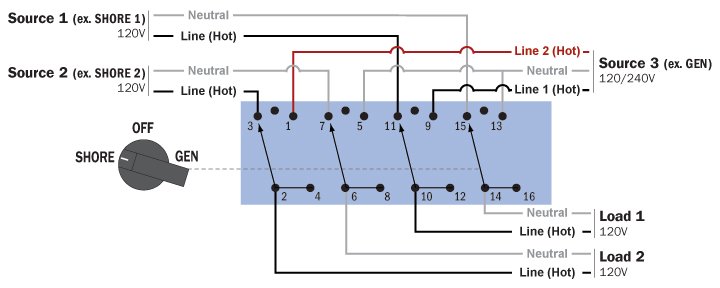Gdavid
Guru
I am connecting the AC wiring for a newly installed generator (new installation, not a replacement) and would appreciate some feedback regarding the ground.
Currently the boat has two 125V 30 amp shore power connections, one feeds the power supply for the air conditioner (nothing else) the other feeds the 125V panel for the boat. I am using a blue seas system switch 6337 that will allow these two circuits to run through the same switch (isolated from each other but controlled by the same lever) or connect to separate legs of the generator 250V so each has 125V. The switch controls the hot and neutral lines for each source and load but does not support grounds. My intention is to tie the grounds from boat loads together with the grounds from the two shore power connection together on one side of a heavy one/off, two post switch (4 wires on a single post) and have the other post connect to a grounding wire leading to the generator), the switch would remain open when on shore power and closed when on generator power to protect from galvanic corrosion and prevent ground fault troubles. An alternate approach would be a galvanic isolator but this seems like an unnecessary item if the AC ground is not bonded to the boat unless away from the dock.
Currently the boat has two 125V 30 amp shore power connections, one feeds the power supply for the air conditioner (nothing else) the other feeds the 125V panel for the boat. I am using a blue seas system switch 6337 that will allow these two circuits to run through the same switch (isolated from each other but controlled by the same lever) or connect to separate legs of the generator 250V so each has 125V. The switch controls the hot and neutral lines for each source and load but does not support grounds. My intention is to tie the grounds from boat loads together with the grounds from the two shore power connection together on one side of a heavy one/off, two post switch (4 wires on a single post) and have the other post connect to a grounding wire leading to the generator), the switch would remain open when on shore power and closed when on generator power to protect from galvanic corrosion and prevent ground fault troubles. An alternate approach would be a galvanic isolator but this seems like an unnecessary item if the AC ground is not bonded to the boat unless away from the dock.
Attachments
Last edited:




